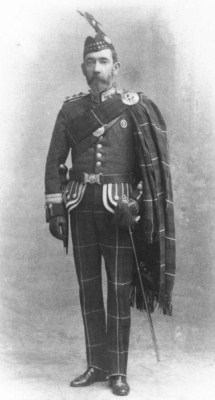Brief History of the Liverpool Scottish
A Brief History
 While the History of the regiment proper spans approximately one hundred years the history of civilian volunteers the British Army goes much further back in time and can be traced back through the 'Trained bands' of the Elizabethan era to the 'Fyrd' which formed Harold's army at Hastings.
While the History of the regiment proper spans approximately one hundred years the history of civilian volunteers the British Army goes much further back in time and can be traced back through the 'Trained bands' of the Elizabethan era to the 'Fyrd' which formed Harold's army at Hastings.
If you click on a heading or follow the menu at the side a more detailed history of the various eras of the regiment can be explored.
The Victorian Era
A more recognizable manifestation however emerged in the later half of the 19th century. Under apparent threat of invasion by the French (again!) a plethora of civilian volunteer units formed across the country. While not a direct ancestor of the Liverpool Scottish one of these units was the The Liverpool Scottish Rifle Volunteers (XIXth Lancashire).
The Territorial Force
In 1900 the Liverpool Scottish was formed in response to the Boer War. A detachment of 22 who saw service with the 4th Service Company of the Gordon Highlanders stands a a marker to the service of many who would follow.
The First World War
The First World War forms the best recorded periods of the Regiments history and the only time it service as a complete unit. The battalion was one of the first of the Territorial Force to arrive in Flanders and later raised two further battalions. Due to the relatively high number of educated men in the ranks a number of diaries, paintings and other memorabilia from both officers and the lower ranks exist.
The Interwar Years
Following the First World War in 1937 the battalion became part of the The Queen's Own Cameron Highlanders. Were it would remain until 1992.
The Second World War
During the 1939-45 war, the 1st Battalion of The Liverpool Scottish remained in Great Britain as a training battalion providing many reinforcements for the Queen's Own Cameron Highlanders battalions (and other Highland regiments) on active service overseas. The 1st. Battalion served in Gibraltar from 1945 to 1947.
The 2nd. Battalion, The Liverpool Scottish, formed at the start of the war, also supplied reinforcements for Highland regiments and, after serving in a home defence role, converted to the 89th Anti-Tank Regiment, Royal Artillery, disbanding in 1946.
Post Second World War.
The 1st Battalion The Liverpool Scottish reformed at the Fraser Street Drill Hall in Liverpool in 1947 and, until its disbandment in 1967 when the Territorial Army was reorganized.
V Company.
In April 1967, The Liverpool Scottish reformed as V (The Liverpool Scottish) Company, 51st. Highland Volunteers AVR II with battalion HQ in Perth.
In October 1992, the Company was transferred and re-designated as V (The Liverpool Scottish) Company, 5th/8th. (Volunteer) Battalion, The King's Regiment with battalion HQ at Warrington.
The Modern Era.
In 1999 as a result of the reorganisation of the Territorial Army The Liverpool Scottish company was disbanded. With fifty Liverpool Scottish soldiers, retaining their distinctive bonnet badge, their Highland dress and their regimental customs, formed part of a new Territorial infantry battalion, The King's and Cheshire Regiment. From July 2006 the King's and Cheshire Regiment of the Territorial Army was reorganized and the King's Regiment companies (A and C Company), including the Liverpool Scottish element joined the 4th Battalion The Duke of Lancaster's Regiment (King's, Lancashire and Border).
Following the Defence Review of 2011 A (Ladysmith) Company was placed into suspended animation and 2 (The Liverpool Scottish) Platoon was disbanded. The Liverpool Scottish was therefore finally removed from the British Army’s Order of Battle after 114 Years of service to the Crown.
The Uniforms
Obviously during the last one hundred years the uniform worn by the Regiment has changed a number of times of which the archive contains a number of images.
The Pipes and Drums
Any Highland military unit has a proud assosiation with the bag pipes and the Liverpool Scottish are no exception. A number of tunes and other memrobilia are contained within the archive. There is also an exhustive section on pipe banners and their heraldry.
Previous page: Home
Next page: The Victorian Era